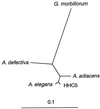Abiotrophia elegans strains comprise 8% of the nutritionally variant streptococci isolated from the human mouth
- PMID: 10405400
- PMCID: PMC85281
- DOI: 10.1128/JCM.37.8.2553-2556.1999
Abiotrophia elegans strains comprise 8% of the nutritionally variant streptococci isolated from the human mouth
Abstract
Ninety-one isolates of nutritionally variant streptococci (NVS) that were previously isolated from the human mouth were regarded as consisting of 7 Streptococcus defectivus isolates, 78 Streptococcus adjacens isolates, and 6 Gemella morbillorum isolates. However, recent references to the taxonomic reclassification of NVS, from S. defectivus to Abiotrophia defectiva and from S. adjacens to Abiotrophia adiacens, and the newly introduced species Abiotrophia elegans as a third Abiotrophia species, emphasize the need for genetic analyses for identification of NVS. When PCR-restriction fragment length polymorphism (RFLP) and phylogenetic distances were examined based on 16S rRNA gene sequences, the results indicated that 7 of the 91 NVS isolates were closely related to A. elegans. These seven isolates consisted of four isolates previously identified as G. morbillorum and three isolates previously identified as S. adjacens. Two isolates previously identified as G. morbillorum were related to A. adiacens. In biochemical tests, A. elegans and the seven isolates related to it possessed arginine dihydrolase (ADH) activity but the other Abiotrophia species did not. As a result, A. elegans strains comprised 8% of the 91 NVS isolates. Our findings suggest that A. elegans, A. adiacens, and A. defectiva exist in the human mouth in proportions of about 1:11:1 and that A. elegans can be genetically distinguished from the other two Abiotrophia species by PCR-RFLP analysis of 16S rRNA gene sequences and can be biochemically distinguished by ADH activity.
Figures


References
-
- Bouvet A, Grimont F, Grimont P A D. Streptococcus defectivus sp. nov. and Streptococcus adjacens sp. nov., nutritionally variant streptococci from human clinical specimens. Int J Syst Bacteriol. 1989;39:290–294. - PubMed
-
- George R H. The isolation of symbiotic streptococci. J Med Microbiol. 1974;7:77–83. - PubMed
MeSH terms
Associated data
- Actions
LinkOut - more resources
Full Text Sources
Molecular Biology Databases
Research Materials
Miscellaneous

